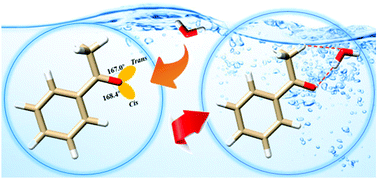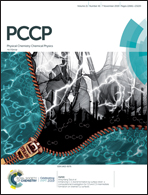Conformational preference determined by inequivalent n-pairs: rotational studies on acetophenone and its monohydrate†
Abstract
Acetophenone and its complex with water have been investigated by using pulsed jet Fourier transform microwave spectroscopy complemented with quantum chemical calculations. Rotational spectra of the acetophenone monomer comprising nine isotopologues were measured and assigned, enabling the accurate structural description of the carbon skeleton. The most stable isomer of the monohydrate of acetophenone was detected in the supersonic jet expansion. Water serves as a proton donor and acceptor forming an O–H⋯O![[double bond, length as m-dash]](https://www.rsc.org/images/entities/char_e001.gif) C hydrogen bond and a secondary C–H⋯O–H weak hydrogen bond with acetophenone through a six-membered ring. The water molecule lies almost in the plane of the aromatic ring. Bader's quantum theory of atoms in molecules, Johnson's non-covalent interaction, electron localization function and natural bond orbital analyses were applied to characterize the nature of the non-covalent interactions in the target complex. All rotational transitions are split into two components arising from the hindered methyl internal rotation. Upon the complexation, the V3 barrier to internal rotation of –CH3 slightly decreases, with 7.50(3) kJ mol−1 for the monomer, and 7.04(5) kJ mol−1 for the acetophenone–H2O dimer, respectively.
C hydrogen bond and a secondary C–H⋯O–H weak hydrogen bond with acetophenone through a six-membered ring. The water molecule lies almost in the plane of the aromatic ring. Bader's quantum theory of atoms in molecules, Johnson's non-covalent interaction, electron localization function and natural bond orbital analyses were applied to characterize the nature of the non-covalent interactions in the target complex. All rotational transitions are split into two components arising from the hindered methyl internal rotation. Upon the complexation, the V3 barrier to internal rotation of –CH3 slightly decreases, with 7.50(3) kJ mol−1 for the monomer, and 7.04(5) kJ mol−1 for the acetophenone–H2O dimer, respectively.



 Please wait while we load your content...
Please wait while we load your content...